

|
|
|
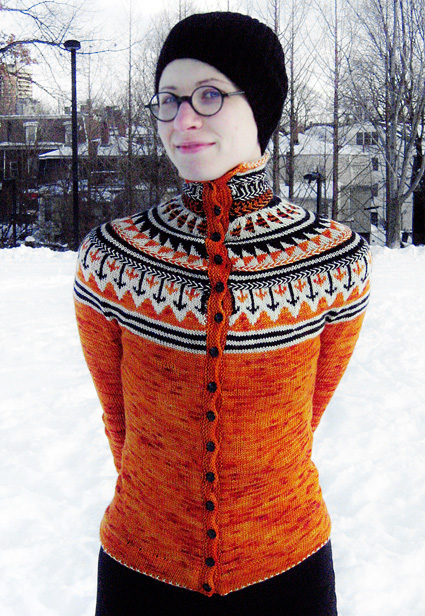 |
My fascination with Dutch athletic uniforms began after I watched the Dutch speed skaters in the 2010 Winter Olympics. Their graphic, aerodynamic suits inspired me to design a mitten pattern this spring called “Go Dutch!”. However, the fascination was intensified when the Netherlands’ national football (that’s “soccer” to the American readers), nicknamed the “Oranje,” made it to the World Cup finals this past summer. I had the good fortune of being in a tiny, old, wood-paneled pub in Rotterdam, watching the game projected onto a screen, when the team beat highly favored Brazil in the quarterfinal match. That day I decided to knit a tribute cardigan, and sketched up this design. This cardigan is as bold as the “total football” of the Oranje, filled with graphic patterns that create both vertical and horizontal movement around the yoke. Surprising details like the striped hem facings, braids, and a row of tiny glass buttons make this piece one of a kind.
|
Don’t be afraid of all the techniques involved in this project! Just take it step by step. If you choose colors that inspire you and make use of all the tutorials available, you’ll love the process and the product! Editor's note: Oranje is pronounced O-rang-ye |
|
|
|
 |
|
SIZE |
|
FINISHED MEASUREMENTS |
|
MATERIALS Notions |
|
GAUGE |
22 sts/36 rows = 4 inches in stockinette stitch using larger needles |
|
PATTERN NOTES |
 Here's a clear, step-by-step
tutorial on sewn steeks. I strongly recommend using sewn steeks if you work this cardigan in a yarn that is not particularly “woolly.” If the yarn won’t felt easily, it’s better to sew your steeks rather than crochet them. The yarn used in the sample, with its soft, smooth hand, will pull free of crocheted steeks and begin to unravel. m1L (left-leaning increase): Insert left needle, from front to back, under horizontal strand of yarn running between last stitch on left needle and first stitch on right needle; knit this stitch through back loop. 1 stitch increased. m1R (right-leaning increase): Insert left needle, from back to front, under horizontal strand of yarn running between last stitch on left needle and first stitch on right needle; knit this stitch through front loop. 1 stitch increased. Knitted Braids: Right-leaning Braid: Left-leaning Braid:
|
The charts for this pattern are very large and fit on a letter-sized page. Click here and print the resulting page. |
|
DIRECTIONS 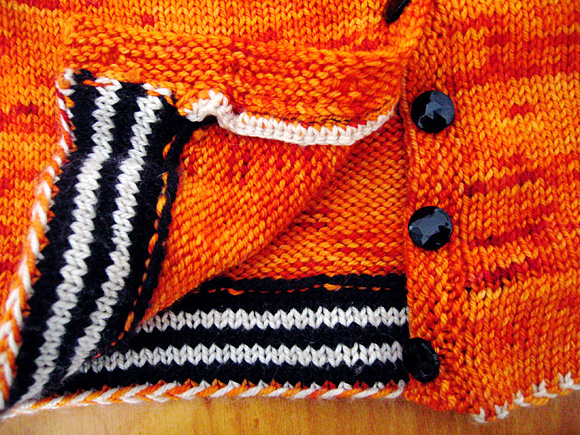
Hem Facing: Using CC1 and long circular needle in smaller size, CO 185[209, 229, 249, 273, 293, 317] sts. Place marker and join to begin working in the round, being careful not to twist. Use marker which is different from the others, to indicate beginning of round. K 2 rounds using CC1. K 2 rounds using CC2. Repeat these 4 rounds once, then k 2 more rounds using CC1. 5 stripes have been worked. Break CC1. Changing to long circular needle in larger size, work braided
turning ridge as follows: Next Round: K46[52, 57, 62, 68, 73, 79], place marker, k88[100,
110, 120, 132, 142, 154], place marker, k51[57, 62, 67, 73, 78,
84]. Work in stockinette st until work measures 4[4, 4, 4.5, 4.5, 5, 5] inches from turning ridge. 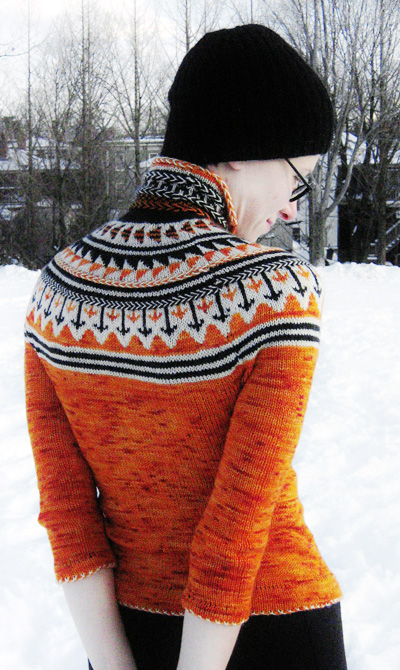 Decrease Round: [K to 3 sts before marker, ssk, k1, slip marker, k1, k2tog] twice, k to end. K 3 rounds. Repeat these 4 rounds 4 times more. 165[189, 209, 229, 253, 273, 297] sts. Increase Round: [K to 1 st before marker, m1R, k1, slip marker,
k1, m1L] twice, k to end. Continue in stockinette st until work measures 13[14, 14, 15, 15, 16, 16] inches from turning ridge or desired length to underarm. Next Round: [K to 5[5, 5, 5, 5, 6, 6] sts before marker, BO
10[10, 10, 10, 10, 12, 12] sts, removing marker] twice, k to
end. Leave steek marker and end-of-round marker in place. 165[189,
209, 229, 253, 269, 293] sts: 78[90, 100, 110, 122, 130, 142]
sts for back, 87[99, 109, 119, 131, 139, 151] sts for fronts
and steek. SLEEVES (Make 2) Cuff Facing: Changing to double-point needles in larger size, work Rounds 1-3 of Right-Leaning Braid, using MC as color A and CC2 as color B. Break CC2; from this point, sleeve will be worked using MC only. Cuff: Joining Round: [Insert tip of left needle into CO st that is
directly behind first st on needle, k this CO st together with
first st on needle] until all sts have been joined. Work in stockinette st until work measures 3 inches. When shaping sleeve, switch to short circular needle in larger size if desired, once enough sts have been increased to move comfortably around the needle. Shape Sleeve: Work Increase Round. K 5[6, 10, 9, 7, 5, 5] rounds. Continue in stockinette st until work measures 13[13, 14, 14, 14.5, 15, 15] inches, ending last round 5[5, 5, 5, 5, 6, 6] sts before end of round. BO 10[10, 10, 10, 10, 12, 12] sts (last 5[5, 5, 5, 5, 6, 6] sts of current round and first 5[5, 5, 5, 5, 6, 6] sts of next round). Break yarn and place remaining 50[54, 58, 62, 66, 70, 74] sleeve sts on hold on short circular needle in smaller size. Make a second sleeve in the same way. Break yarn but do not remove sts of second sleeve from working needle(s). 
Pick up lower body and resume working using attached ball of yarn, working all sts onto long circular needle in larger size, as follows.  Work in stockinette st until work measures 1[1.5, 2, 2.5, 2.5, 3, 3] inches from joining round. When working last round, increase or decrease as follows (see note below): Sizes XS and S: Increase 5 sts. Size M: Increase 1 st. Sizes L, 1X, 2X and 3X: Decrease 3 sts. 270[302, 326, 350, 382, 406, 438] sts. Note: When instructed to increase or decrease stitches within a round, be sure to space increases or decreases evenly across round. Do not work increases or decreases over steek sts. When shaping yoke, switch to shorter circular needle in larger size when necessary. Work Rounds 1-27 of Chart A. K 1 round using CC1. K 1 round using CC2. K 2 rounds using CC1. Work Rounds 1-9 of Chart B. Work Rounds 1-14 of Chart C. Sizes XS, S, L, 1X, 2X, 3X Only: Size M Only: Using CC2, k2, [k1, k2tog] to 2 sts before steek marker, k to end. 99 sts. All Sizes: Next Round: Using CC1, k all sts, decreasing 3[1, 1, 3, 5, 7, 9] sts. 78[94, 98, 102, 110, 114, 122] sts. Work Rounds 1-3 of Right-Leaning Braid, using MC as color A
and CC1 as color B. Switching to shorter circular needle in smaller size, work collar
facing as follows: |
|
FINISHING Steeks: Steam steek edges toward WS of cardigan, and pin if desired. You will be picking up stitches for the front button bands along the outer edge stitches of the steek. 
Before picking up front band sts, fold, steam and pin hem and collar facing sts toward WS of sweater. When picking up hem and collar facing sts for bands, pick up facing st with body st and k these sts together; the picked-up sts will hold the edges of the hem and collar facings in place. Bands are worked in garter stitch. Buttonhole Band: K 3 rows. Button Band: Sew buttons to button band opposite buttonholes. Hem, Cuff and Collar Facings: 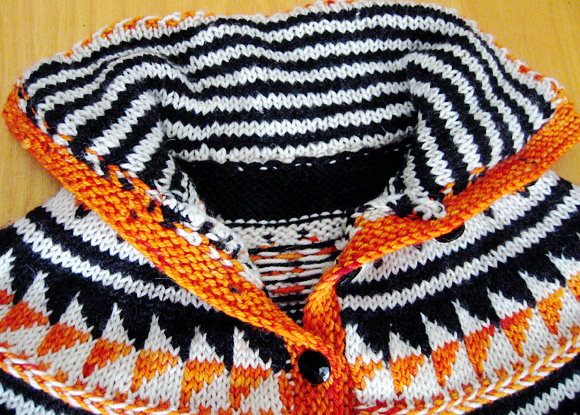
|
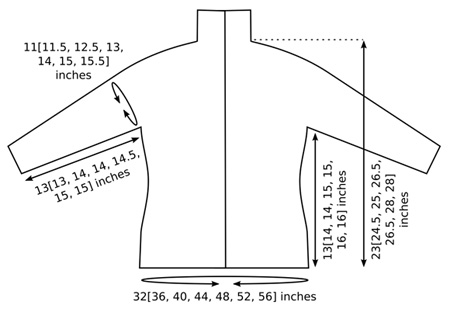
|
| ABOUT THE DESIGNER |
|
|
|
Pattern & images © 2011 Weaverknits. Contact Ann |